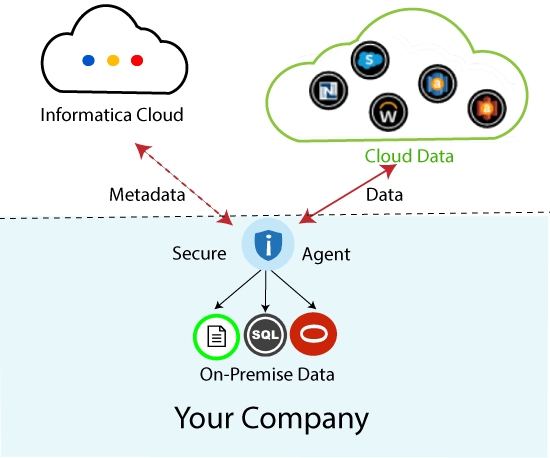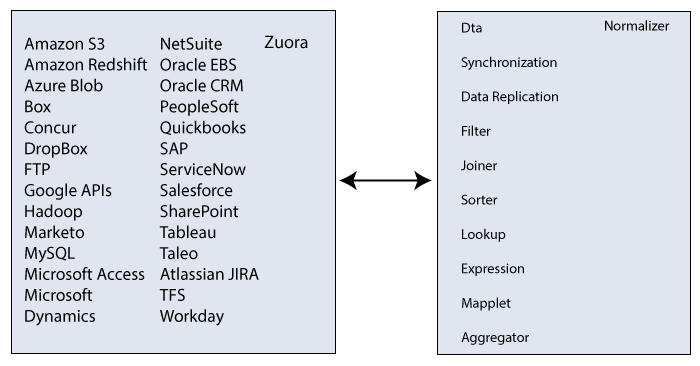Informatica CloudInformatica Cloud is a data integration solution and platform that works Software as a Service (SaaS). Informatica Cloud can connect to on-premises, cloud-based applications, databases, flat files, file feeds, and even social networking sites. Informatica Cloud Data Integration is the cloud-based Power Center, which delivers accessible, trusted, and secure data to facilitate more valuable business decisions. Informatica Cloud Data Integration can help the organization with global, distributed data warehouse and analytics projects. If we are using a cloud data warehouse such as AWS Redshift, Azure SQL Data Warehouse, or Snowflake, then Informatica Cloud Data Integration solutions improve the overall performance, productivity, and extensive connectivity to cloud and on-premises sources. Informatica Cloud Connectors deliver connectivity to an enterprise application or database. Connectors exist for many systems, including ACORD, Google BigQuery, Goldmine, JD Edwards, MS Access, MS Dynamics, MS Great Plains, MS Navision, Netsuite, Oracle EBS, Salesforce, SQL Database, and SWIFT Transformation. ArchitectureThe architecture of the Informatica cloud shows through the following image, such as: 
Secure Agent In Informatica Cloud architecture, the Secure Agent is a lightweight program. And it is used to connect on-premise data with cloud applications. It is installed on a local machine and processes data locally and securely under the enterprise firewall. All upgrades and updates are automatically sent and installed on the Secure Agent regularly. Connectors The connectors are the second central part of the Informatica Cloud architecture. These are pre-built integration solutions for data, devices, and connecting applications. Connectors are used to connectivity with Cloud applications (Salesforce, Workday, Amazon Redshift) and on-premise applications (SQL Server, Dynamics CRM, Teradata) 
Informatica Cloud ComponentsInformatica Cloud has the following components, such as:
ConnectivityThe below image shows the connectivity of the Informatica cloud, such as: 
Use CasesThe Informatica cloud has the following use cases, such as: 1. Data Synchronization
2. System Maintenance Tasks
3. Data Replication
4. Mappings
5. Monitoring
DevelopmentIn Informatica Cloud, Development is divided into Data Synchronization Tasks and Mappings. Data Synchronization tasks are ETL based tasks. We can load the data from a source to a target with the help of data synchronization and provide some transformation during transfer. Mappings are flows that allow for chaining multiple complex operations such as joins, filters, and functions together to build a complex integration process. ReportingIn Informatica Cloud, Reporting is divided into Activity Log and Activity Monitoring. The Activity Log is responsible for generating a summary report of all successful and unsuccessful executed jobs. And Activity Monitoring is responsible for creating a list of all currently running jobs. Each job is listed along with starting date or time, as well as rows processed. Each process is also provided with information such as date, time, status, success rows, error rows, and error message. The user can drill down into each job and download a session log that contains execution information details at the logging level.
Next TopicInformatica MDM
|
 For Videos Join Our Youtube Channel: Join Now
For Videos Join Our Youtube Channel: Join Now
Feedback
- Send your Feedback to [email protected]
Help Others, Please Share









